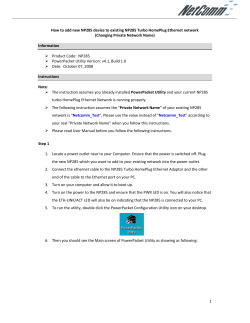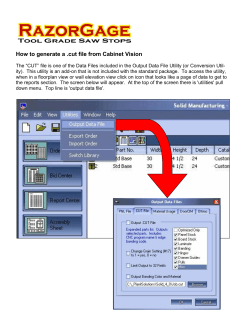
- International Journal of Scientific Engineering and
International Journal of Scientific Engineering and Technology Volume No.4 Issue No5, pp: 298-301 ISSN : 2277-1581 01 May. 2015 Minimizing Hot and Cold Utility Requirements for Vegetable Oil Refinery Plant Using Pinch Analysis *Bello Zubairu, Bitrus K. Highina , Babagana Gutti Department of Chemical Engineering, Faculty of Engineering, University of Maiduguri, Borno State, Nigeria. Corresponding Email: * zubairubello24@ yahoo.com Abstract:Pinch technology is applied on various process flow diagrams from process industries using different strategies or techniques. These techniques include both graphical procedure (Thermal Pinch diagram) as well as algebraic procedure (Temperature interval diagrams) in order to compare the minimum heating and cooling utility requirement of a process with the actual requirement. In this present research work, the process flow diagram of vegetable oil refinery received from an industry. The hot and cold streams are identified and Pinch analysis technology is applied in order to find out the minimum heating and cooling utility requirement. Hot utility reduction is around 21.3% while the cold utility reduction is around 10.2% by Graphical method while the percentage of hot utility reduction is 8.3% and that of cold utility is 4.0% by Algebraic method therefore, the application of graphical method is recommended. Keywords: Algebraic procedure, Graphical procedure, Heat integration, Pinch Technology and Vegetable oil Refinery. INTRODUCTION The importance of energy in today’s society is increasing given rising world-wide population and the associated demand for resources. Modern as well as developing nations need a substantial amount of energy to maintain or improve the standard of living of their citizens upon which a stable societal framework can prosper. To achieve this, it is required to have access to energy sources to ensure continued economic growth and innovation of these nations in addition to maintaining a balance with the ecology. Therefore, a major environmental and economic goal in today’s world is to find the right mix of technologies and practices to help meet present and future energy demands and at the same time minimize pollution. A major component in this mix is improved energy efficiency. In the process industries, process integration strategies involving thermal systems provide an effective means to reduce energy use and environmental emissions. One of the most successful technique for investigating energy integration and the efficient design of heat exchanger networks is pinch technology. Pinch Analysis uses thermodynamic concepts and heuristics [2 - 7]. Pinch technology is a complete methodology based on thermodynamic principles that can be used to design new plants with reduced energy and capital costs and for existing processes; to evaluate efficiency and provide potential design modifications to improve performance. A fundamental strength of pinch analysis is that it determines the most appropriate set of heat IJSET@2015 exchange stream matches. In doing so, minimizes energy loss, reduces the cost of hot and cold utilities and can be used to determine the minimum requirement for both hot and cold utilities in a process and thus, enhance process integration [8]. In this present research work the process flow diagram of Vegetable oil refinery was obtained from industry and Pinch analysis techniques were applied in order to find the minimum heating and cooling utility requirement. The main idea of this research is to find the energy available and saved from the process plant. Process description of vegetable oil refinery The vegetable oil refinery plant under analysis is based on traditional tail-end technology, comprising two sections, chemical and physical sections. The chemical section is a section where the neutralization of oil is taking place (Batch) while the physical section is a section where bleaching and deodorization are taking place. The oil is first heated from 50 oC to 110oC using the heat exchanger before the oil send to the bleacher after that then filtration follows; the temperature of the oil will reduce to 90 oC. The oil temperature will rise again from 90 oC to 200 oC using heat exchanger from there the oil will send to deodorizer where the temperature will increases to 230 oC. The top product will cooled from 180 oC to 50 oC while the bottom product will also cooled from 230 oC to 60 oC as shown in the Figure 1 . Figure 1; process flow diagram of vegetable oil refinery Page 298 International Journal of Scientific Engineering and Technology Volume No.4 Issue No5, pp: 298-301 MATERIALS AND METHODS Materials The materials used are process flow diagram (PFD) and the plant data of vegetable oil refinery of Afcott Nig Plc as shown in Figure 1. Method Two methods were used for the application of pinch technology on the process flow diagram of vegetable oil refinery. These include Graphical method or Thermal pinch diagram and Algebraic method or Temperature interval diagram. Graphical method procedure The Graphical method procedure is as flows: Fix ΔTmin Construct the hot and cold composite curve Draw the hot composite curve and leave it fixed Draw the cold composite curve in such a way that the smallest ΔT = ΔTmin The temperature at which ΔT = ΔTmin is the pinch The non – overlap on the right is the minimum heating utility and the non – overlap on the left is the minimum cooling utility. Algebraic method procedure The Algebraic method procedure is as flows: Divide the temperature range in to intervals and shift the cold temperature scale Make the heat balance in each interval Cascade the heat surplus/deficit through the intervals Add heat so that no deficit is cascaded. Formulation of the Problem Table (Thermal Data) This is the collection of the process stream and equipment (heat exchangers and utilities) parameters and tabulated as shown in Tables 1 and 2. The heat load or heat duties of the heat exchangers were estimated using equation 1 and tabulated in Tables 1 and 2. Q = CpxFxΔT Where Cp = specific heat capacity of the stream (kJ/kgoC), F = mass flow rate of the stream (kg/s), ΔT = temperature difference (oC), Q = heat exchanger duty (kJ/s) Determination of the Specific Heat Capacities Here the data for given work has been taken from information available on the production rate of the various fractions and their specific heat capacities and several of the temperature recorded by thermocouple. Hence it is possible to form preliminary heat and mass balance, and data for existing heat exchanger. However, some information is unknown, including number of temperature. These unknown streams information are calculated by back calculation. Cp=1.9330+0.0026T [9] Where: Cp is the specific heat capacity T is the mean temperature of inlet and outlet temperature of the process stream. ISSN : 2277-1581 01 May. 2015 Table 1 Problem Table of Vegetable oil Refinery Legend Cp = Specific Heat Capacity (kJ/kg OC) CP = Heat Capacity rate ( kJ//sOC) F = Mass Flow rate (kg/s) H = Enthalpy change rate (kJ/s) O Tin = Inlet Temperature ( C) O Tout =Outlet Temperature ( C) Table 2 Revised Problem Table of Vegetable oil Refinery Legend CP = Heat Capacity rate (kJ/sOC) H = Enthalpy change rate (kJ/s) Table 3 Temperature and Enthalpy Selection Legend I H = Initial Enthalpy Selection (kJ/s) H = Enthalpy change rate (kJ/s) O T = Temperature Interval ( C) RESULTS AND DISCUTIONS IJSET@2015 Page 299 International Journal of Scientific Engineering and Technology Volume No.4 Issue No5, pp: 298-301 ISSN : 2277-1581 01 May. 2015 Table 4 Actual and Minimum Heating and Cooling utilities of Graphical Method Legend AHUR = Actual Hot Utility Requirement (kJ/s) MHUR = Minimum Hot Utility Requirement (kJ/s) %HUR = Percentage Hot Utility Reduction ACUR = Actual Cold Utility Requirement (kJ/s) MCUR = Minimum Cold Utility Requirement (kJ/s) %CUR = Percentage Cold Utility Reduction Table 5 Actual and Minimum Heating and Cooling utilities of Algebraic Method Legend AHUR = Actual Hot Utility Requirement (kJ/s) MHUR = Minimum Hot Utility Requirement (kJ/s) %HUR = Percentage Hot Utility Reduction ACUR = Actual Cold Utility Requirement (kJ/s) MCUR = Minimum Cold Utility Requirement (kJ/s) %CUR = Percentage Cold Utility Reduction Legend H = Enthalpy (kJ/s) T = Temperature (oC) Figure 3 Composite Curve of ΔTmin = 10oC Figure 2 Temperature Interval Diagram Table 6 Table of Exchangeable Heat Load (TEHL) Figure 4 Cascade Diagram IJSET@2015 Page 300 International Journal of Scientific Engineering and Technology Volume No.4 Issue No5, pp: 298-301 Thermal Pinch diagram was constructed by plotting composite hot and cold streams on a single temperature versus enthalpy plot using graphical procedure as shown in Fig 3. From Thermal Pinch Diagram the minimum heating utility requirement was found to be 185kJ/s and minimum cooling utility requirement was found to be 492.5kJ/s respectively. Temperature interval diagram (TID) was constructed using Algebraic procedure as shown in Fig 2. Considering the highest and lowest temperature of hot and cold streams the TID was constructed with eight intervals. Using TID, the TEHL for process hot streams and process cold streams were prepared as shown in Table 6. A cascade diagram was prepared by plotting total load of hot and cold streams on the right and temperatures on the left hand side and making a heat balance across each interval. A revised cascade diagram was constructed (since there were negative residual heat loads in the cascade diagram) by adding the most negative residual heat on the top of cascade diagram and making the heat balance across each interval as shown in Fig 4. It observed that there were no negative residual heat loads in the revised cascade diagram and hence there exists thermodynamic feasibility. Therefore, the minimum hot and cold utility requirements were 215.5kJ/s and 473kJ/s respectively. CONCLUSION In this present research work using pinch technology for reducing hot and cold utility requirements of vegetable oil refinery yielded the following: the hot and cold utility requirement of Graphical method are 185 kJ/s and 492.5kJ/s respectively while the Algebraic method yielded 215.5 kJ/s and 473 kJ/s respectively for hot and cold utility requirement. Hot utility reduction is around 21.3% of the total heat load while the cold utility reduction is around 10.2% of the initial cold utility IJSET@2015 ISSN : 2277-1581 01 May. 2015 demand of Graphical method while the percentage of hot and cold utility reduction of Algebraic method are 8.3% and 4.0% respectively therefore, in this present research the application of Graphical method is preferable than using the Algebraic method. Pinch analysis as an energy integration technology saves more energy and utilities cost than the traditional energy technology. The technology can also apply to any process industries. References i. Olsen D. and Welling B. (2011). Practical Heat Integration Analysis in the process industries. Geneva 4 – 9 September world engineers’ convention. Ii .Linnhoff, B. and Flower, J. (1978), Synthesis of heat exchanger networks. I. Systematic generation of energy optimal networks. AIChE Journal, 244, 633– 642. iii. Linnhoff, B., Mason, D. R., and Wardle, I. (1979), Understanding heat exchanger networks. Compute. Chem. Eng., 3, 295– 302 iv. Linnhoff, B., Tows end, D.W., Boland, D., Hewitt, G F., Thomas, B. E. A., Guy, A. R., and Marsland, R. H. (1982) A user guide on process integration for the efficient use of energy. UK: The Institute of Chemical Engineers. v. Gundersen, T. and Naess, L. (1998). The synthesis of cost optimal heat exchanger networks—an industrial review of the state of the art. Computes Chem. Eng., 126, 503–530. vi. Linnhoff, B., and Hindmarsh, E. (1983). The pinch design method for heat exchanger networks. Chemical Engineering Science, 38, 745–763. vii. Linnhoff, B. (1994), Use pinch analysis to knock down capital costs and emissions. Chemical Engineering Progress, 32–57. viii. Promvitak P., (2001). ―Retrofit Design of Heat Exchanger Networks of crude distillation unit‖, Petroleum, Petrochemical & Advanced Materials, 7, 5-12 ix. Formo M. W. (1979). Physical properties of fats and fatty acids, in Balley’s Industrial oil and Fat products (edd. Swem), 4 th edition, volume 1, John wiley and sons, New York, NY, Pp 177 – 232. Page 301
© Copyright 2025









